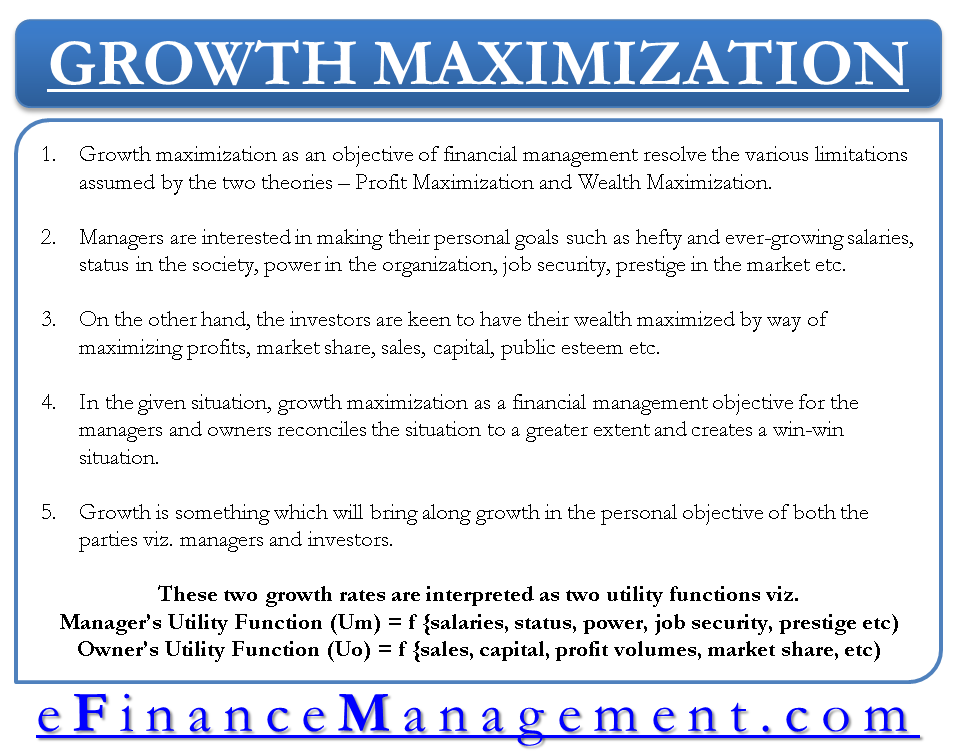Financial management objectives play a crucial role in guiding the decision-making process within organizations. Traditionally, profit maximization has been considered the primary objective. However, as financial theories evolved, wealth maximization emerged as a more holistic approach. Despite their merits, both profit maximization and wealth maximization have their limitations. This article critically evaluates the viability of growth maximization as a financial management objective.
Need for Growth Maximization as an Objective of Financial Management
The parties affected by financial management goals are broadly the managers and the owners/shareholders. It is well understood that they have their set of personal objectives. They will be satisfied and continue their support only if their personal goals are achieved while acting for the organization’s objectives.
Managers are interested in achieving their personal goals such as hefty and ever-growing salaries, status in society, power in the organization, job security, prestige in the market, etc. It is very logical from the angle of the managers to run behind their goals to smoothly run their life cycle.

On the other hand, investors are keen to maximize their wealth by maximizing profits, market share, sales, capital, public esteem, etc. Since they have invested their hard-earned money in the business, they are also logical in asking for the due returns on their invested sum.
Also Read: Wealth Maximization
In this situation, growth maximization as an objective reconciles the situation to a greater extent and creates a win-win situation. Growth is something that will bring along the personal objective of both the parties, viz. managers and investors. A growing organization in terms of its sales, market share, profits, etc., will automatically lead to improved returns or maximization of the investors’ wealth. Similarly, for the managers, it will be able to provide job security and good and growing salaries at the pace of an organization’s growth. At the same time, the credit of taking the organization to such levels will bring them status and prestige.
Growth Maximization Theory
Professor Penrose and Marris define a balanced growth rate to be an objective of financial management. They assume that growth means the growth rate of demand for the product produced/sold by the organization and the rate of growth of capital supply to the organization. It is also assumed that both the growth rates should be equal to achieve the maximum balanced growth rate.

The key points of this theory are as follows:
Balanced Growth Rate
Professor Penrose and Marris propose the concept of a balanced growth rate as an objective of financial management. They assume that this rate is achieved when the growth rate of demand for the organization’s product aligns with the growth rate of capital supply to the organization. According to their theory, achieving equal growth rates in demand and capital supply results in the maximum balanced growth rate.
Manager’s Utility Function
The theory assumes that managers have a utility function, representing their personal objectives and motivations. This utility function includes factors such as salaries, status, power, job security, and prestige. The theory suggests that managers are primarily motivated by these personal goals. And, their actions are driven by their desire to fulfill these objectives. The growth rate fo this funaction is interpreted as:
Also Read: Profit vs. Wealth Maximization
Manager’s Utility Function (Um) = f(salaries, status, power, job security, prestige etc.)
Owner’s Utility Function
Similarly, the theory assumes that owners or shareholders have a utility function that reflects their objectives. This utility function comprises elements such as sales, capital, profit volumes, and market share. It is believed that owners seek to maximize their wealth and returns on investment. And, their decision-making is influenced by these financial considerations. The growth rate for this function is interpreted as:
Owner’s Utility Function (Uo) = f(sales, capital, profit volumes, market share, etc.)
Alignment of Managerial and Owner Interests
The growth maximization theory assumes that the personal goals and objectives of managers and owners are aligned with each other. It suggests that by pursuing growth, both parties can achieve their respective objectives. Managers can benefit from increased job security, higher salaries, and enhanced status and prestige, while owners can experience improved returns on their investments and increased wealth.
Motivation through Growth
The theory postulates that a higher growth rate for the organization serves as a motivating factor for managers and owners alike. By focusing on growth, the theory argues that both parties can find common ground and work towards achieving the shared objective of maximizing the organization’s growth rate. This shared objective is believed to incentivize managers and owners to collaborate effectively and drive the organization’s growth.
Since the personal interest of both owners and managers are in harmony with each other. The single objective of achieving a higher growth rate for the firm motivates the managers and owners.


Great effort to put every thing and help people to understand the concept of Financial Management.